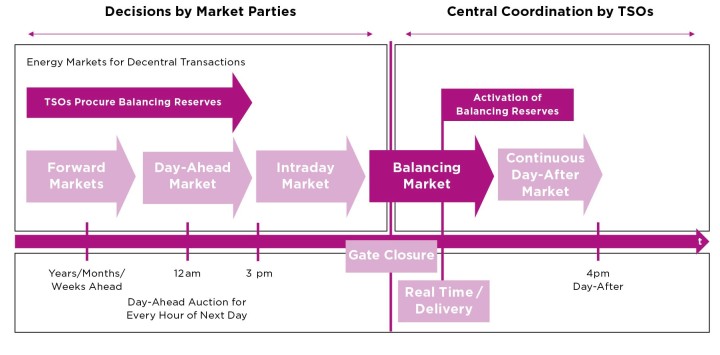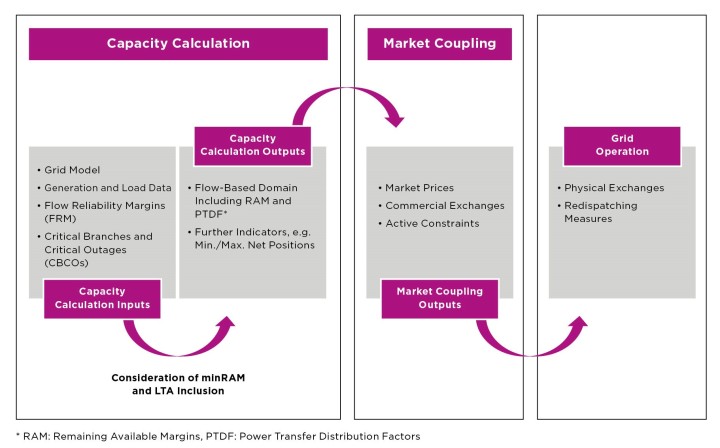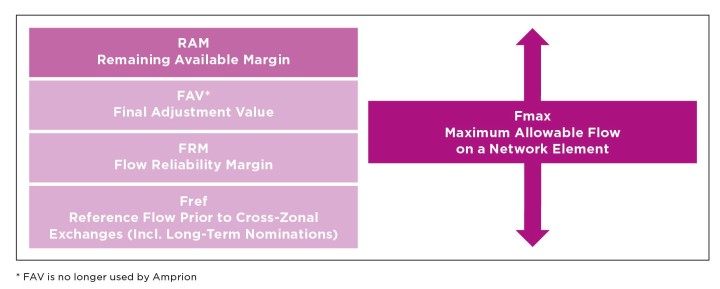Overview Electricity Markets in Europe
The concept of market timeframes and Flow-Based Market Coupling
Electricity is a non-storable good which needs to be produced at the point at which it is consumed in real time. Trading of electricity takes place before and after this point in time. Figure A gives an overview of the current trading time sequence in wholesale and balancing markets. In sequential order, energy can be traded year(s) before the delivery (Forward and Future Markets) up to the day after the actual delivery. While in the day-ahead market energy is traded one day before real time, the intraday market enables market participants to correct their nominations on the delivery day itself.

Figure A: Overview of different timeframes of the wholesale and balancing markets
Forward and Futures Markets
Forward and Futures products allow market participants to hedge themselves against short-term price uncertainties. The markets for these long-term products start from years before up to days before the actual delivery. Forwards are usually traded over-the counter (OTC) between two involved parties without being standardised, whereas futures are standardised contracts which are traded on power exchanges.
Day-Ahead Market and Flow-Based Market Coupling
The main focus of the Amprion Market report is the day-ahead timeframe and the Flow-Based Market Coupling. Relevant inputs and outputs of the FB MC as well as the subsequent grid operation are illustrated in Figure B. In a zonal electricity market, the available capacity between bidding zones is determined by translating physical transmission constraints into commercial transaction constraints (see step ‘Capacity Calculation’ in Figure B). These simplified commercial transaction constraints are then considered in the market clearing algorithm determining market prices and cross-zonal exchanges between participating bidding zones (cf. step ‘Market Coupling’ in Figure B). Congestions occurring after the Market Coupling require redispatching measures, which are coordinated by affected TSOs during real-time grid operation (cf. step ‘Grid Operation’ in Figure B ).

Figure B: Overview of flow-based capacity calculation and market coupling
Main feature of Flow-Based Market Coupling: direct consideration of physical transmission constraints in the market
The main enhancement of the FB MC compared to the NTC1-based market coupling is the (direct) consideration of physical transmission constraints in the market clearing algorithm. Accordingly, all critical network elements relevant for cross-zonal exchanges (so-called critical branch critical outage combination (CBCO)) are taken into account in the market clearing, bringing commercial transactions closer to the physical reality. The impact of cross-zonal commercial transactions (i.e. change of bidding zones´ net positions) on flows through relevant critical network elements is determined by multiplying them with so-called Power Transfer Distribution Factors (PTDFs). In other words, the PTDFs describe how much electricity flows through particular network elements if certain (incremental) cross-zonal commercial transactions are taking place. In CWE, only network elements that fulfil a cross-zonal relevance criterion2 are considered a potential constraint in the Market Coupling algorithm (as so-called CBCOs).
Flow on critical network element induced by cross-zonal trade = PTDF · Bidding Zone Net Position
The flows through those critical network elements induced by cross-zonal trade are then limited to the Remaining Available Margin (RAM) on the elements. In other words, the RAM is the margin which is available on critical network elements for commercial transactions or cross-zonal trade in CWE. Hereby, the RAM is derived from technical parameters and the system state within the flow-based capacity calculation process.
The RAM3 is determined by subtracting a reference flow (Fref), a Flow Reliability Margin (FRM) and a Final Adjustment Value (FAV)4 from the maximum allowable flow (Fmax).
RAM = Fmax – Fref – FRM – FAV

Figure C: Determination of the maximum allowable flow [5]
Finally, the flow-based domain is defined by the described parameters, representing all feasible combinations of commercial exchanges between participating bidding zones. Hence, in contrast to the NTC-based approach, commercial exchanges between two bidding zones are dependent on feasible commercial exchanges between other bidding zones. The crucial role of the appropriate determination of input parameters is explained in further detail in the appendix.
The main advantage of FB MC is a better representation of the physical characteristics of the transmission grid. This enables a less conservative consideration of capacities, i.e. flow-based parameters, leading in most cases to a larger flow-based domain and higher welfare gains than under the NTC-based approach.
The Appropriate Determination of Input Parameters is Crucial
To calculate flow-based capacities, TSOs have to prepare several inputs used in the capacity calculation process. Fundamentally, TSOs consider best estimates of the state of the CWE electric system containing forecasts with regard to grid topology, generation and load. In particular, generation and load assumptions can considerably impact the system state and therefore determine the active constraints and corresponding exchange capabilities.
Moreover, TSOs have to determine parameters for the relevant critical network elements, i.e. maximum current on a critical network element (Imax) and Flow Reliability Margins (FRM). In order to map changes in net positions to the generating units in a bidding zone, Generation Shift Keys (GSK) are defined. To ensure secure power system operation, TSOs take into account remedial actions during capacity calculation, e.g. change of the tap position of a phase shifter transformer or other topological measures.
Another important parameter in the FB MC capacity allocation is the consideration of so-called phase shifter transformers (PSTs). Phase shifters are grid elements which help the TSOs to handle the flows. By changing the PST tap position, load flows and therefore potential congestion are reduced and allow the TSOs to offer more capacity to the market parties. The impact of the PSTs is not limited to the area surrounding the PSTs but the effects can be seen on the overall European network. The coordination of these devices is a key process of the D-2 Flow-Based capacity calculation in CWE to enlarge the Flow-Based Domain (or in other words: to enlarge the trading possibilities) while respecting security of supply. Against this background, the assumptions taken for the position of all phase shifters during the FB MC are a major parameter to the FB MC outcome.
Another important parameter in the FB MC capacity allocation is the consideration of so-called phase shifter transformers (PSTs). Phase shifters are grid elements which help the TSOs to handle the flows. By changing the PST tap position, load flows and therefore potential congestion are reduced and allow the TSOs to offer more capacity to the market parties. The impact of the PSTs is not limited to the area surrounding the PSTs but the effects can be seen on the overall European network. The coordination of these devices is a key process of the D-2 Flow-Based capacity calculation in CWE to enlarge the Flow-Based Domain (or in other words: to enlarge the trading possibilities) while respecting security of supply. Against this background, the assumptions taken for the position of all phase shifters during the FB MC are a major parameter to the FB MC outcome.
Artificial Increase of the Flow-Based Domain
Since 26th April 2018, a mandatory minimum RAM of 20 % on all critical network elements in CWE has been applied (so-called minRAM), without any further grid security considerations.6 As part of the European legislative electricity market framework released in 20197, the Regulation (EU) 2019/943 on the internal market for electricity provides for an increase of this minimum trading capability to 70 % starting from 1st of January 2020. However, several TSOs have been granted a timely restricted derogation from this rule. If structural congestions in a bidding zone prevent the provision of a 70 % margin in 2020, member states are entitled to publish a so-called action plan explaining the reasons and future measures that will ensure a stepwise implementation of the 70 % minRAM until 1st of January 2026. Amongst other member states, Germany has opted for such an exemption clause8.
Enhancement of Day-Ahead Markets and Flow-Based Market Coupling
In order to achieve the target model of a single European electricity market, local markets have been gradually integrated and coupled at a regional level as from 2006 with the first market coupling of the Belgian, Dutch and French day-ahead markets. The latest major step towards the target model was the introduction of FB MC in CWE back in 2015. Currently, TSOs are already working on the introduction of FB MC in the Capacity Calculation Region (CCR) Core, which encompasses Eastern Europe in addition to Central and Western Europe.
Intraday Market
European-wide intraday coupling is an additional key component for achieving the single European energy market. With the rising share of fluctuating generation, connecting intraday markets through cross-zonal trading is an increasingly important tool for market participants to keep positions balanced. The Single Intraday Coupling (SIDC) of local intraday markets is realised in the Cross-border Intraday (XBID) project. Its purpose is an increase in the overall efficiency of intraday trading. The second wave go live of the XBID project in November 2019 has been an important step towards the overall European market integration adding seven additional countries. XBID is now bringing together 21 countries9. The project partners consist of the European nominated electricity market operators (NEMOs), EPEX SPOT, GME, NordPool and OMIE as well as the North Western European and Baltic TSOs.
| Notes: |
|---|
|
1 Net Transfer Capacity (NTC) 2 Usually a minimum zonal PTDF of 5 % 3 Prior to minRAM adjustment and inclusion of long-term allocation (LTA) 4 FAV can be used by TSOs to reduce or increase the RAM on a critical network element for very specific reasons, i.e. system security reasons. Amprion completely removed its FAV values in the beginning of 2017, thus dispensing with a further reduction of the RAM. 5 Prior to minRAM adjustment 6 Via an artificial increase of the flow-based domain 7 The ‘Clean Energy for All Europeans Package’ entered into force on 4th July 2019. 8 An overview on the ‘Clean Energy Package’ and its relevance for the future market and grid situation is provided in Section 6.1. 9 First 14 countries: Sweden, Norway, Finland, Estonia, Latvia, Lithuania, Portugal, Spain, France, Netherlands, Belgium, Germany, Austria and Denmark; 7 additional countries: Bulgaria, Croatia, Czech Republic, Hungary, Poland, Romania and Slovenia |